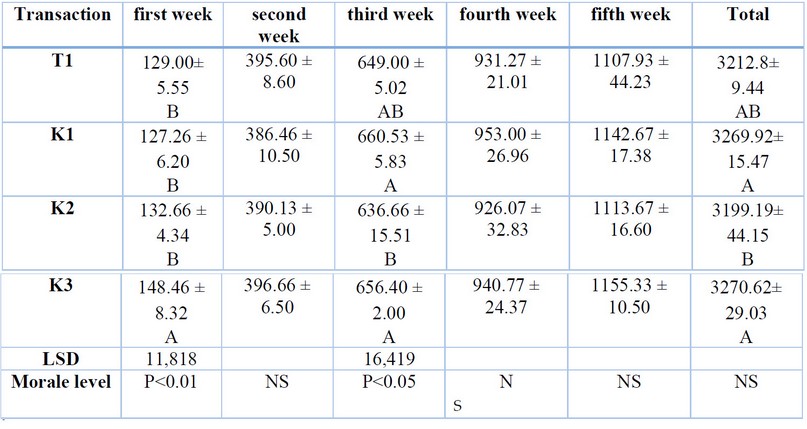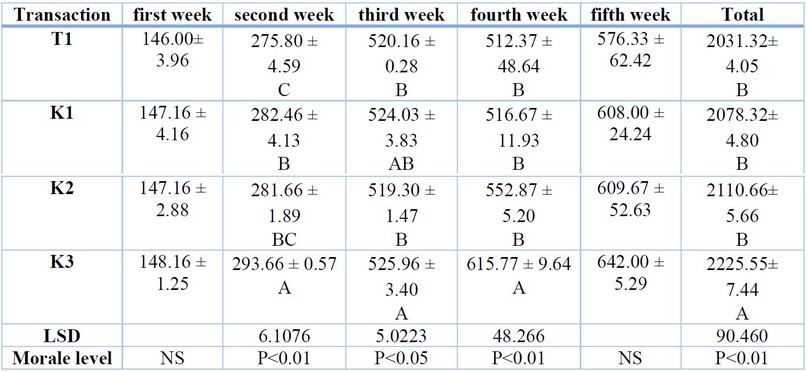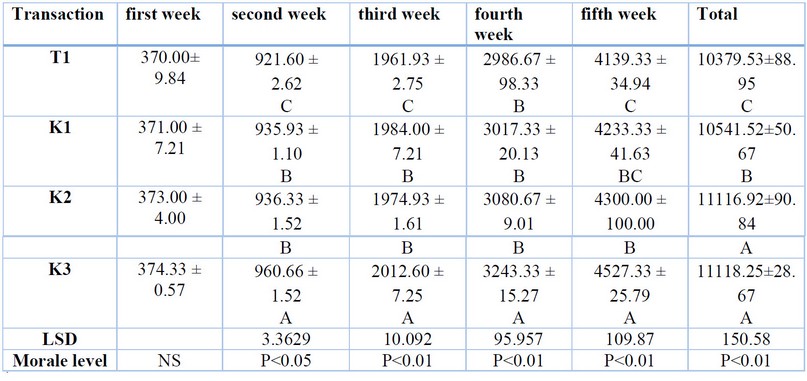2023.08.04.79
Files > Volume 8 > Vol 8 no 4 2023
Growth performance of broiler chickens of turmeric (Curcuma longa) turmeric aqueous extract
Baqer, H.
1*, Salah Gatea
2, Salam Altaie
3, Thamer ALjanabi
4
1
Department of Animal Production, Agriculture
College/ Kerbala University/ Iraq;
2
Department of Animal Production/ Agriculture
College/ Kerbala University/ Iraq; Email: [email protected].
3
Department of Animal Production/ Agriculture
College/ Kerbala University/ Iraq; Email: [email protected].
4 Department of Animal Production/
Agriculture College/ Kerbala University/ Iraq; Email: [email protected].
*
Correspondence: [email protected]
Available from. http://dx.doi.org/10.21931/RB/2023.08.04.79
Available from. http://dx.doi.org/10.21931/RB/2023.08.04.79
The effects of Turmeric Powder extract
(TPE) on the growth performance of broiler chicken were evaluated in the 5-week
study. On 240-day-old chicks weighing 40.9g, levels were supplemented with
turmeric powder extracts (TPE) in the water of broiler chicken. In conclusion,
there was increased final live weight and weight gain, a better feed conversion
ratio (FRC), and body and feed intake with the highest TPE on water. The serum
metabolites were not affected by the level of TP in the diets. It was concluded
that levels supplemented with turmeric powder Extracts (TPE) in the water of
broiler chicken appear to act as a growth promoter with no adverse effect on
health status.
Keywords: turmeric; broiler; growth
performance.
INTRODUCTION
In poultry production, herbs have become a potential antibiotic
substitute in poultry nutrition1. Alternatives to replace
antibiotics are called phytogenic feed additives, including probiotics,
prebiotics, enzymes, and essential oils. Phytogenic growth promoters mainly
enhanced gut health for optimum functioning 2. Turmeric
supplementation stimulates the bird's digestive system by promoting intestinal
lipase, maltase, and sucrose activities and the secretions of pancreatic
amylase, lipase, chymotrypsin, and trypsin activities3. The findings
showed improved body weight gain and FCR turmeric supplementation4.
The supplementation of curcumin increased the villus height and width and
increased epithelial cells in all segments (duodenum, jejunum, and ileum) of
the small intestine of the digestive system.
This study aimed to evaluate the potential use of different levels
of turmeric powder extract additive in water on broiler chickens' growth
performance and production during the study.
The study was conducted in. Karbala, College of Agriculture,
Department. Animal. Production was from 15/3/2021 to 20/4/2021. Two hundred forty-one-day-old
chicks were used, and the average body was. Weight was 40.9 g. of Ross 308
breed. The duration of the study was 5 weeks. Chickens were distributed
randomly for four treatments and three replications of each treatment. Each
treatment contained 60 chicks. The temperature is fixed at about 34- 35 °C in
the first week and then decreases gradually to 2.3 °C per week until it reaches
21 - 23 °C. The illumination regime was a 12-hour light-dark cycle.
Preparation of the aqueous extract and method of use:
Turmeric was obtained from local markets, and the aqueous extract
was made according to the modified Hernandez method by mixing an amount of
powder with a volume of distilled water in a ratio of 1 g/ 2 ml of water and
mixing them with a mixer. The solution then was presented in a water bath to a
temperature of 60 degrees. C- For an hour, the solution is left, and then the
solution is left overnight at room temperature. Then, the clear solution is
filtered. by sterile gauze before using determined ingredients by analysis and
using NRC 9
The results in Table 1 show the influence
of fortification aqueous extract of turmeric powder on broiler chickens'
average body life weight During the trial period of 1 - 35 days. The results
differed significantly at P˂0.05 in the mean of the weight of the body of the
added treatments. The extraction of turmeric for chicken water compared to a comparison.
Treatment. The significant increase in body weight continued during the
breeding period. However, a significant increase was found in the fourth
treatment, outperforming the rest of the additional treatments. This result
agreed with researcher 10, who found a significant improvement in the
productive properties of chicks added with different turmeric levels compared
to control chickens.

1T. T1: control treatment without addition. K2: The second treatment
is adding an aqueous turmeric powder extract at a concentration of 10 ml/liter
of water. 3: A third treatment by adding an aqueous turmeric powder extract at
a concentration of 20 ml/liter of water. K4: The fourth treatment. Averages ± Standard Error.
Table 1. This is a table. Tables should be placed in the main text
near the first time they are cited.

2T. T1 control
treatment without addition. K2: The second treatment is adding an aqueous
turmeric powder extract at a concentration of 10 ml/liter of water. 3: A third
treatment by adding an aqueous turmeric powder extract at a concentration of 20
ml/liter of water. K4: The fourth treatment. Averages ± Standard Error.
Table 2. Shows the effect of adding an aqueous turmeric powder
extract on the total forage consumption rate during the experiment.
Table 3 shows the effect of adding the aqueous extract to turmeric
powder on the food conversion factor during the experiment. There was a
significant improvement in the feed conversion factor for the fourth treatment
compared with the control treatment. At the same time, however, we did not find
a significant difference between the experimental and control treatments.

3T. T1: control
treatment without addition. K2: The second treatment is adding an aqueous
turmeric powder extract at a concentration of 10 ml/liter of water. 3: A third
treatment by adding an aqueous turmeric powder extract at a concentration of 20
ml/liter of water. K4: The fourth treatment.
. Averages ± Standard Error.
Table 3. Effect of adding turmeric extract on the food conversion factor.
Table 4. Effect of adding the aqueous extraction to turmeric
powder on the rate of weight gain during the experiment period, where we did
not find significant differences in the weekly weight gain rate of the
extracted treatments compared to the control treatment, while in the second
week, there were significant differences among the experimental treatments and
control. There were significant differences among experimental treatments in
the third and fourth weeks.

4T. T1: control
treatment without addition. K2: The second treatment is adding an aqueous
turmeric powder extract at a concentration of 10 ml/liter of water. 3: A third
treatment by adding an aqueous turmeric powder extract at a concentration of 20
ml/liter of water. K4: The fourth treatment. Averages ± Standard Error.
Table 4. The effect of adding turmeric extract on weight gain
Table 5: The effect of using the aqueous extract of turmeric powder on
the relative growth rate during the experiment period, where there was an
improvement in the relative growth rate of the treatments added to the turmeric
extract to chicken water compared to the control. In the fourth week, there was
a significant improvement in the control treatment.

5T. T1: control treatment without addition. K2:
The second treatment is adding an aqueous turmeric powder extract at a
concentration of 10 ml/liter of water. 3: A third treatment by adding an
aqueous turmeric powder extract at a concentration of 20 ml/liter of water. K4:
The fourth treatment. Averages ± Standard Error.
Table 5. The effect of adding turmeric extract on the relative growth of
chicks
Table 6 shows the
effect of using the aqueous extraction of turmeric powder on the water
consumption rate during the experiment period, as there were significant
differences in the water consumption rate of the extract treatments compared
with the control.

6T. T1: control treatment without addition. K2:
The second treatment is adding an aqueous turmeric powder extract at a
concentration of 10 ml/liter of water. 3: A third treatment by adding an
aqueous turmeric powder extract at a concentration of 20 ml/liter of water. K4:
The fourth treatment. Averages ± Standard Error.
Table 6. The effect of adding turmeric extract on the water consumption rate.
The improvement in the productive traits
of chickens for broilers to which the aqueous turmeric extract was added to
water during the experimental period may be attributed to the presence of
active compounds in the extract. At high levels, especially Hydrolysable
phenolic acids, flavonoids, and tannins, which help improve the digestion of
nutrients by stimulating the secretion of digestive enzymes, which enhances the
digestion of the food intake, and this, in turn, helps improve the overall
growth of broilers. This result agrees with researcher 11, who found
significant differences P≤0.05 in the final average body weight and the mean
weight gain of turmeric-supplemented treatments during the rearing period. This
also agrees with researcher 12. who found significant improvements of P˂0.05 in
the weight gain rate of the treatment supplemented with turmeric compared to
the control during the Breeding period. The active substances present in
turmeric also act as antioxidants and anti-inflammatories, which improve the
functioning of the alimentary canal in the absorption of nutrients 13
and consequently lead to an increase in feed consumption for birds, and this is
consistent with the findings of the researcher 10., which found a
significant improvement, P˂0.05, in the rate of feed consumption for the
treatment supplemented with turmeric water extract compared with the control
treatment during the rearing period. As well as to the role of turmeric in the
moral increase of the physiological structure of the small intestine in terms
of the height of the villi and its surface area, and the villi rose to the
depth of the Rajput crypts) 14. (Turmeric works to improve the
growth and reproduction of beneficial bacteria that are initially inside the
small intestine of birds, which is positively reflected in improving the rate
of food consumption and the health status of birds 15, improving the
food conversion factor, which agrees with the researcher 16, which
found a significant improvement of P˂0.05 in the feed conversion factor of the
turmeric-supplemented treatment. Compared with the control during the rearing
period, we conclude the role of turmeric extract in improving the environment
of the alimentary canal in food digestion and increasing the absorption of
nutrients, which leads to significant productivity improvement traits of
chickens.
CONCLUSIONS
The study
investigated the effects of feeding aqueous turmeric extract to broiler
chickens. The results showed that the extract significantly positively affected
the chickens' growth rate, feed intake, and food conversion ratio. These
effects were likely due to active compounds in the extract, such as hydrolyzable
phenolic acids, flavonoids, and tannins. These compounds have antioxidant and
anti-inflammatory properties, and they can improve the functioning of the
alimentary canal to improve nutrient absorption and digestion. The extract also
positively affected the growth of beneficial bacteria in the small intestine of
the chickens, which further enhanced their nutrient absorption and overall
health.
Based on the
results of this study, it is concluded that feeding aqueous turmeric extract to
broiler chickens can significantly impact their growth and overall health. The
extract should be considered as a potential feed additive for broiler chickens.
Author Contributions: "Conceptualization.
Salam Altaie; methodology, Salam Altaie. And Salah Gate; validation, Thamer
ALjanabi; formal analysis, Salam Altaie.; investigation, Baqer, H..; resources,
Salah Gate.; data curation, Salam Altaie.; writing—original draft. Preparation,
Salah Gate.;. Writing—a review. And editing, Salah Gate.; visualization. Sura
Khafaji and Baqer, H.; supervision, Salam Altaie.; project administration,
Baqer, H.
Funding: This research. Received no external funding.
Institutional Review Board Statement. "The study was conducted according to the guidelines of the Declaration of
Helsinki and approved by the Institutional Review Board (Agriculture College,
Kerbala University, Iraq)
1.
Lillehoj H, Liu Y, Calsamiglia S, Fernandez- Miyakawa M E, Chi F,
Cravens R L, Oh S and Gay C G 2018. Phytochemicals as antibiotic alternatives
to promote growth and enhance lost health. Veterinary Research 49 (76):1-18.
2.
Yitbarek M B 2015. Phytogenics as feed additives in poultry
production: a review. International Journal of Extensive Research 3: 49-60
3.
Plate K and Srinivasan K 2000. Influence of dietary spices and
their active principles on pancreatic digestive enzymes in albino rats. Food/
Nahrung 44 (1): 42-46.
4.
Daramola. O T.2020.Growth performance and serum metabolites of
broiler chickens fed turmeric (Curcuma longa) powder-supplemented diets.
Received 22 June 2020; Accepted 5 October 2020; Published 1 December 2020.
5.
Mustafa,M.M;Karadas ,F;and Taayed,L.T.2021. Adding a different
level of turmeric powder and curcumin to the diet on broiler performance,
carcass traits, immunity, and gut morphology of broiler chicken under normal
and heat stress conditions. Iraq journal of agricultueral scinces
-2021:52(2):512-526.
6.
SAS. 2012. Statistical Analysis system. User's Guide. Statistical
version. 9th.ed. Inst-Inc Cary, NC.The USA.
7.
Duncan, B. D. 1955. Multiple Range Test and Multiple F-Test.
Biometrics. 11: 1- 42.
8.
Hernandez, M., R. Lopez , R.M. Abanas, V.
Paris and A. Arias. 1994.
Antimicrobial activity of Visneamocanera Leaf extracts. J. Ethnopharmacology.
41; 115-119.
9.
AL-Ameri. SMK and ALjashami, S.M.2017.study the effect of adding
two levels of Curcuma longa and caryophylius Eugenia to the broiler chicken on
the production performance. 9(2). 801-789
10.
Saed, Z. J. M., Mohammed, Th. T. & Farhan, S. M. Effect of
ginger and celery seeds as feed additives on reproductive performance of
broiler breeder males. Plant Archives.2018,18(2): 1823-1829.
11.
Daramola. O T.2020.Growth performance and serum metabolites of
broiler chickens fed turmeric (Curcuma longa) powder-supplemented diets.
Received 22 June 2020; Accepted 5 October 2020; Published 1 December 2020.
12.
Mahmood, N. A. & Abdulateef, S. M. Determining Some Undesirable
Behavioral Traits and Their Impact on the Behavioral Performance of Broiler
Chicks. in IOP Conference Series: Earth and Environmental Science .2021,vol.
904.
13.
Godara ,K.V and Singh,A .2019 . Effect of feed restriction and
turmeric powder supplementation on broiler performance.Haryana Vet. (Dec.
2019)58(2),254-256.
14.
Rajput,N., N.Muhammad, R.Yan, X.Zhong and T.Wang .2013.Effect of
dietary supplementation of curcumin on growth performance, intestinal
morphology and nutrients utilization of broiler chicks.J.Poult.Sci.50:44-52
15.
R. Aziz, S., A. Rashid, S. Impact Of Using Sunflower Seed Meal In
Broiler Male Diets On Performance Traits And Carcass Characteristics. Anbar
Journal Of Agricultural Sciences, 2023; 21(1): 148-157. doi:
10.32649/ajas.2023.179726.
16.
Mondal ,M.A. ,Yeasmin,.T.,Karm,.R. ,Nurealam
Siddiqui,M.,Raihanun-Nabi, .S.M. Sayed ,. M .A .and Siddiky , . M.N.A .2015. Effect of dietary
supplementation of turmeric powder on the growth performance and carcass traits
of broiler chickens.SEARCH.Agri.13(1);188-199.
Received: 26 September 2023 / Accepted: 15 April
2023 / Published: 15 December 2023
Citation: Baqer, H.; Gatea, S.; Altaie, S.; ALjanabi.T.; Growth performance of broiler chickens of turmeric (Curcuma longa) turmeric aqueous extract. Revis Bionatura 2023;8 (4) 79. http://dx.doi.org/10.21931/RB/2023.08.04.79
Publisher's Note: Bionatura stays neutral concerning jurisdictional claims in
published maps and institutional affiliations.
